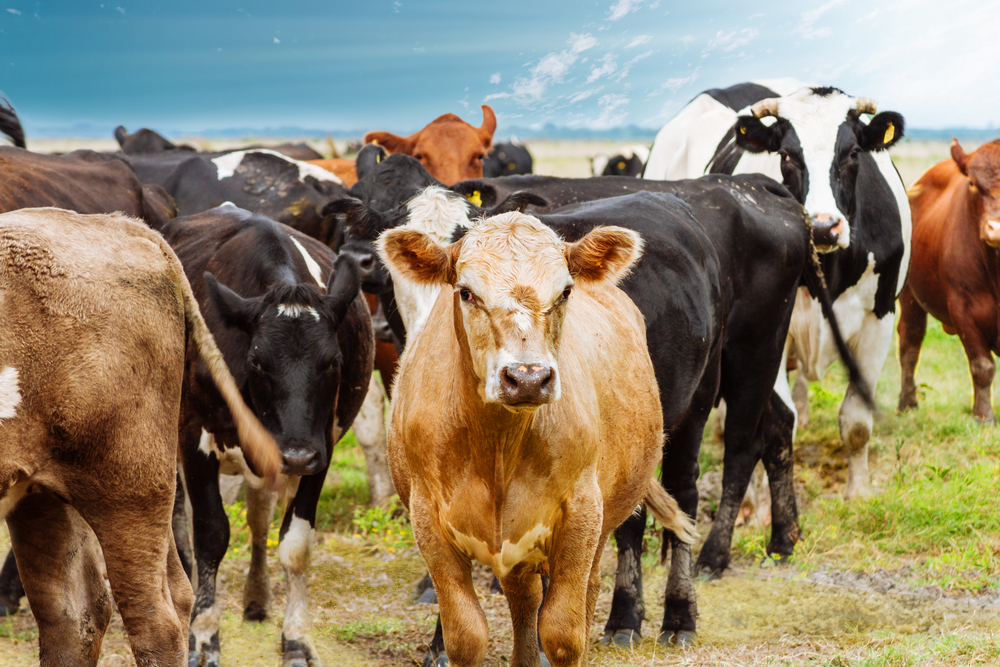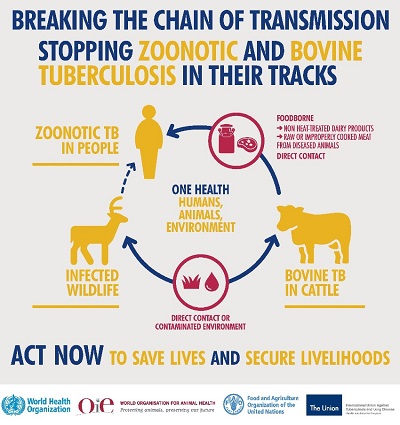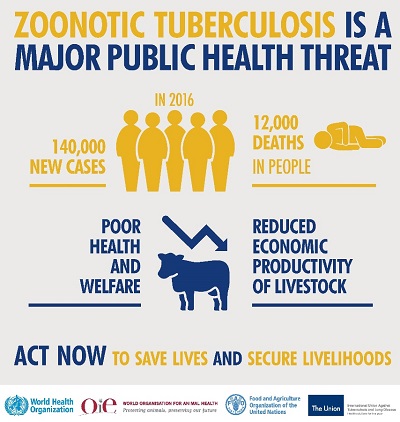
The bovine tuberculosis is a disease which is caused by the bacteria known as Mycobacterium bovis. It usually affects animals such as cattle, buffalo, and many other mammals causing illness, coughing, and even death. It can affect lungs, lymph nodes and many other parts of the body. Mainly its transmission occurs from animals to humans and also to the other animals. M. tuberculosis is the type of bacteria that causes the disease in humans different from M. bovis. The name of tuberculosis is due to the formation of nodules known as tubercles which are formed in the lymph nodules of the infected animals.
History of tuberculosis
Robert Koch was the person who discovered the tubercle bacillus as the main cause of tuberculosis in 1882. Theobald Smith further published his report about human and bovine tuberculosis in 1898. He described 2 different organisms which are now called Mycobacterium bovis and Mycobacterium tuberculosis.
There are more than 180 countries who reported the situation of bovine tuberculosis to the OIE (world organization for animal health) from 2017 to 2018. But more than 80 countries had reported the presence of this disease. Many countries have controlled this infection but still, it is a serious disease for humans and animals in developing countries. There is a higher number of cases in many parts of Asia and Africa, but other countries of Europe and America have also reported this infection.
Morphology of Bovine tuberculosis-causing organism
They are gram-positive bacteria and catalase-positive. They are non-motile and non-spore forming bacteria. Mycobacteria are rod-shaped bacteria with a length of 1.0-10 micrometer and width 0.2-0.6 micrometer.

Transmission of Bovine tuberculosis
The disease can be transmitted directly from infected animals or indirectly by the ingestion of contaminated substances. Mainly this organism is carried in the airborne particles having a diameter of 1-5 microns. These droplets are produced when persons have pulmonary or laryngeal tuberculosis disease. TB is transmitted from person to person by air due to cough or sneeze. Humans can also develop this infection by the consumption of raw milk of infected cattle or through contact with the tissues of the infected animals at abattoirs.
Bovine tuberculosis has slow onset as it takes months or even years to reach the stage where it becomes fetal. The infected animal can spread the bacteria on the farm before the appearance of clinical signs. So the major role for the spread of this disease is the undiagnosed infected animals.
Many people are at low risk for this infection but those who work on animal farms and the places where meat, milk and other animal-related products are handled are at high risk.

Signs and symptoms of tuberculosis in humans
- Fever
- Weight loss
- Night sweats
- Diarrhea
- Cough
- Abdominal pain
- Breathing difficulties
- Loss of appetite
- Weakness
- Gastrointestinal disturbances
Signs and symptoms in animals
- Weakness
- Emaciation
- Anorexia
- Fever
- Enlarged lymph nodes
- Chronic moist cough
- Snoring respiration
- Difficulties in respiration
Diagnosis in humans
The tuberculin test is mainly used for the diagnosis of TB by injecting the antigen into the skin and then checking the immune reaction. The definitive diagnosis is done by growing the bacteria in the laboratory but it takes at least 8 weeks.
The TB blood tests and TB skin tests are usually performed to detect the presence of TB in suspected persons. The chest x-rays tests can also be performed and the sample of sputum is also required for the detection of TB in the person.
Diagnosis in animals
The tuberculin test is the standard test for the detection of bovine tuberculosis in the animals. The bovine tuberculin (a protein which is extracted from M. bovis) is injected intradermally and then measures the thickness of the skin at the injection site after 72 hours.
PCR is also used for the presence of mycobacterium. It is a reliable and faster method. The duration of this test is just 3 hours, so it is a rapid test as compared to other tests.
The blood tests are also used widely as gamma interferon release assay as it detects the cell-mediated immune response to infection. The elevated level of gamma interferon is produced if the blood cells have previously exposed to M. bovis by an infection.
Public health concern of Bovine tuberculosis
Tuberculosis is a disease that has infected individuals for more than 4,000 years. There are more than 1 million deaths per year due to TB in the world, and more than 90 % of cases are in developing countries. More than 1.4 million people died in 2018 due to TB. This chronic infection spreads from one person to another by air, and it affects the lungs, kidney, intestine, and many other organs of the body.
TB is one of the leading causes of morbidity and mortality in many countries especially developing countries. The chemotherapy of TB was discovered in 1940. There are fewer cases of TB in developed countries than in developing countries. There are more cases of males as compared to females, so care is necessary for men.
In Pakistan, there are more than 25000 new cases of TB reported every year, and more than 50,000 deaths occur per year. There are more than 300,000 patients who are benefited from free treatment every year in Pakistan.
Prevention and control measures for tuberculosis
- Separate the infected and healthy ones
- Proper testing of new animals on the farm
- Postmortem examination to see the tubercles in liver, spleen, intestine, and other parts of the body of the infected animals
- Unpasteurized milk products should be avoided
- Always take care while purchasing the milk products from the market
- Workers who work on animal farms should be checked regularly
- Good biosecurity of the farm should be maintained
- Separate the wildlife and livestock population
- The feed of livestock animals should be away from the wildlife
- Monitoring of animals should be regularized
- Pasteurization of milk and milk products should be performed regularly
- Vaccinate the wildlife for protecting the livestock population
- Different areas for wildlife should be made to reduce the transmission to livestock
- The clean feed should be provided to the animals
- Store the feed of animal in those places which are away from the approach of wildlife
- Complete care of infected one is very important in this infection
- Clean and safe food should be provided to humans and animals
- Health care workers should focus on those who are at risk
- Surveillance activities should be performed at slaughterhouses
- Cleanliness should be maintained
- Special care for those who are homeless, intravenous drug users and with a weak immune system
- TB should be declared as a world health emergency to provide special care to the patients
- The living conditions of people should be improved
- Educate the people about this infection
- The infected people should be placed in separate and well-ventilated areas
- Personal hygienic conditions should be maintained
- People should adopt a healthy lifestyle
- The public should be made aware of basic knowledge of TB
- Health care workers should be checked regularly as they are at risk
- The treatment of TB should be free of cost
Treatment
Usually, the treatment of bovine tuberculosis is not performed in cattle. But in many countries, Isoniazid is used in cattle with the dose rate of 10-25 mg/kg daily for 2 months. Rifampin, Isoniazid, and Ethambutol are also used in combination in zoo animals. The main focus is to control it. The culling of infected animals is mainly recommended as control measures. In humans, many medicines such as Isoniazid, Pyrazinamide, Ethambutol, and Rifampin are used. But the person has to take the medicine for a period of six to nine months to ensure complete clearance from tuberculosis causing bacteria.
Author: Gohar Khadim, Department of Pathobiology, Faculty of Veterinary Sciences, Bahauddin Zakariya University, Multan, Pakistan
A good one article
But I have a query that how would just one can distinguish it from TB caused by M. tuberculosis in human beings???? and the drug used has some side effects which are to some extent similar to its signs and symptoms. Then how would one can distinguish that whether he/she is getting better or infection is becoming severe????
According to my study, firstly it was thought that pyrazinamide given intreatment for tb caused by tuberclosis is resistant to M.bovis.. but in vivo studies proved this wrong as M.bovis was somehow susceptible to pyrazinamide. Furthermore, TB due to M. bovis is clinically, radiologically and microscopically indistinguishable from disease caused by M. tuberculosis. It has different colony morphology on culture plate than M.tuberclosis..
The answer of second question is that signs and symptoms well indicate whether the infection is getting better r severe …Weight gain and loss has a key role … if the patient is gaining weight then he/she is recovring from the disease.. but if the he/she is losing weight even after the treatmnt then the disease is getting worse…futhermore the radiograph of lungs too show whether the patient is curing or not …if the lesions have not increases and are same like they were diagnosed then the patient is ge1tting cured but if the lesions are expanding even after the medication then the disease is getting worse
According to my study, firstly it was thought that pyrazinamide given intreatment for tb caused by tuberclosis is resistant to M.bovis.. but in vivo studies proved this wrong as M.bovis was somehow susceptible to pyrazinamide. Furthermore, TB due to M. bovis is clinically, radiologically and microscopically indistinguishable from disease caused by M. tuberculosis. It has different colony morphology on culture plate than M.tuberclosis..